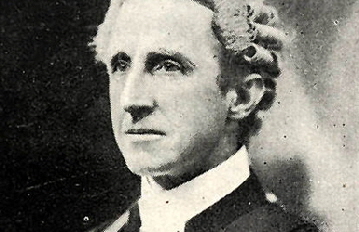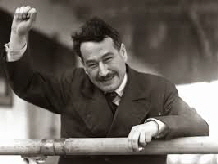 |
||||||||
|
|
||||||||
 |
||||
|
Below is an essay first published, in abridged form, in the 2014 Summer edition of the Centre for Independent Studies’ Policy Magazine.
|
||||
|
Dulcie versus Leviathan Is government media in Australia even constitutional? On the Bolt Report 26th May 2013 an erstwhile Howard government minister was asked whether privatizing the ABC would be a good thing. Rather than answering in the negative he made pains to evade the question, leading one to believe that there are politicians who would like to do so but fear the controversy. If only they had the courage of a poor ship stoker’s wife in 1934 who railed against the authorities giving her a fine for the simple pleasure of listening to station 2KY on her radio in the privacy of her solitary boarding house room, alas without the required listener’s licence. All federal legislation has to come under, what is called, a head of power, being some article in the Constitution which authorises Parliament to ‘…make laws…with respect to:’ that particular sphere. For controlling broadcasting in general and maintaining government media organisations such as the ABC and SBS in particular, this has been considered to be Section 51 (v) where laws can be made regarding ‘…postal, telegraphic, telephonic and other like services’. This affirmation came from an obscure High Court of Australia (HCA) case of 1935, R v Brislan, which challenged the government’s right to charge radio listeners licence fees. After being given the fine in September 1934 by Roy Vincent Brislan, an inspector of the department of the Post Master General (PMG), Dulcie Williams, of Surry Hills, Sydney, a barely literate wife of a R.A.N seaman, decided that rather than pay the one quid, she would challenge the right of the PMG to make her pay for listening to her ‘all-electric wireless receiving set’. Was Ms Williams a latent libertarian who harboured liberal philosophical thoughts denouncing Leviathan for wanting to control the airwaves? That she came under the sway of a smart lawyer who believed he could win her case and thus free her of her fine as well as win the costs for himself, is probably closer to the truth. To represent Dulcie in court the lawyer retained a prominent barrister of the times, Albert Piddington, who was no fool. Subsequent to lodging the appeal but before the hearing, an ancillary charge was brought to the HCA for contempt of court by The Sydney Sun newspaper, for how it allegedly prejudiced Ms Williams’ case. Taking on a major newspaper with all its resources was no mean feat but the charge was upheld and Piddington also won costs. However if he was to believe he would similarly be successful in his original case he was mistaken. The HCA was obviously keener to punish those who dare treat it with contempt than to set a precedent by ruling invalid, legislation similar to popular legislation of the time, which created the Australian Broadcasting Corporation. Despite the issues and characters involved, this intriguing case has been almost forgotten by history, yet should elicit a number questions from anyone with an interest in Australian law. The first one of course being: why on earth is it called ‘The Crown versus Brislan’? Brislan was the PMG licence inspector who worked for the Crown. The case was about a private citizen, Dulcie Williams, challenging a law of the Crown that Brislan was upholding. By rights it should be Williams versus Brislan, or Williams versus the Crown (re R.V. Brislan). Odd as it may seem, this confusing nomenclature was standard Australian practice of the time for prerogative writs. Is it the same, or just similar? To aid analysis it must be noted that this Section 51(v) actually covers two categories. Commentators often fail to make the distinction which leads to confusion as to interpreting a ratio decidendi (the rationale for the decision) of the case. Either the government is involving itself in something which is one of either a postal, telegraphic or telephonic service, (what could be called the equates argument), or secondly, involving itself in an undertaking which, while not actually being postal, telegraphic nor telephonic, is similar and falls within the genus, the common denominator, of the three (the genus argument). Some writers assume the case was decided on the genus argument and go on to declare how it was an example of the Constitution of 1901 being written to not only accommodate contemporary practices and concepts, but also some yet to be invented. With regards to the latter they are indeed, correct. What would better fit within the genus descriptor of “other like services” than emailing or phone texting? Both are private, person-to-person, reciprocal, communication services where no stretch of credulity would be needed to justify government involvement. However most of the majority justices were smart enough to realise the visible flaws in applying it in this situation, as mentioned below, and if they were going to deny the appeal they would have to find a way to rationalise that radio broadcasting was, in itself, either a postal, telephonic or telegraphic service. Their Honours of the Majority In leading the majority opinion Chief Justice Latham began with the equates argument. In defending his It has been suggested that a telephone is an instrument which provides communication from point to point only, and that if what is heard at the receiving end is available for all bystanders to hear, the communication is not telephonic in character. This argument does not appear to be sound. If an amplifier is attached to an ordinary telephone receiver the essential character of the operation, which consists in what is ordinarily described as the reproduction of sounds at a distance, is not changed.6 Well, yes it is. As the dissenting judge declared, a primary characteristic of the telephone is inter-communication, hearing to what is said from a particular person and then responding to it. With broadcasting, ‘There is no inter-communication; no means is provided by which one individual can originate a message or establish communication with another...’7 Perhaps the Chief Justice realised he was on shaky ground with that rationale. In any event, he added the genus argument to his rationale.
The common characteristic of postal, telegraphic and telephonic services, which is relevant in this connection is, in my opinion, to be found in the function which they perform. They are, each of them, communication services.8 Considering they were also all private, person to person, reciprocal communication services, it does seem a bit of a stretch to take a step back and describe their “common characteristic” merely as communication. If John Latham had been sent out by his wife to buy carrots, celery, spinach or other like items, would he have dared return home carrying deep-fried chicken and Angel cake because, after all, they were all foodstuffs? Judges George Rich and H.V. Evatt, on the other hand, seemed not to want to depend on—or touch with a 50 foot barge pole—the genus argument. In delving into constitutional law history, specifically of mistakes made by the United States, they spoke of the lessons learned by ‘…the framers of the Australian Constitution and accordingly they expressed themselves in terms calculated to cover developments in science and organization enabling the control of analogous and ancillary services…’9 (emphasis added). It would be difficult to interpret this in any other way than the learned brethren referring to the phrase ‘or other like services’. The judges then declared that unlike telephony, ‘…broadcasting does not give the advantage of one man communicating with another when he wishes…’10 also admitting that ‘The distinction [between broadcasting and telephony] is apparent.’11 So, after declaring that ‘[The head of power of 51(v) was] intended to provide for the future and bearing upon its face an attempt to cover unknown and unforseen developments…’12 do they take advantage of this genus phrase ‘…calculated to cover developments in science…’ and justify broadcasting under it? Without reason, they did not. Their final comment was that this later developed science of broadcasting, which denies ‘the advantage of one man communicating with another when he wishes’, still, ‘…is a telephonic service.’13 Compared to Latham’s almost five thousand words, the 277 words of Justice McTiernan’s opinion was the shortest of the case and the thought that went into it appeared commensurate. Since the decision …In re Regulation and Control of Radio Communication in Canada the view must be accepted that broadcasting …, may be classed with telegraphic and telephonic services. 14 True, they may be in the same class, but was the honourable gentleman aware of the actual wording of section 51(v)? The service had to actually be telegraphic (or telephonic) or alternatively be in the same class of not just telephonic and telegraphic, but telephonic, telegraphic and postal. Finally there was the idiosyncratic ruling from Justice Heyden Starke, a judge known to be independent, hostile with some of his colleagues, and often dissenting.15 He also followed the Privy Council decision from In re Regulation and Control of Radio Communication but, unlike McTiernan, read from the case that ‘…broadcasting fall[s] within the …word telegraphs…’16 The genus argument So why was the genus argument hardly used? The majority High Court judges were forced to give these tortured arguments that broadcasting was actually the same thing rather than simply declaring it was similar, for very good reasons. If, for the sake of the argument, we were to accept Latham’s reasoning that post, telephone and telegraph were simply “communication services”, where would it lead us? If this radio one-to-many communication is a ‘like service’, then because the non-electrical postage was also within the genus, it follows that all one-to-many communications whether electrical or not, could also fall under government control. This would then obviously include the printed word: newspapers and other journals. So if the meaning of section 51(v) also includes the government’s right to control the press, surely something as important as this would have been specifically mentioned by the drafters of the constitution, rather than simply assumed by the words ‘telephonic’, ‘telegraphic’ and ‘postal’? A rough count gives the number of words in the Australian Constitution to be 11,204, which includes some subsections which possess only one word. Are we to believe the drafters meant control of the press was to be included, but didn’t want to add another subsection containing ‘the press’, because at 11,206 it would then make the Constitution too long? Piddington When Kings Counsel for Dulcie, Albert Bathurst Piddington, referred to the ‘secrecy and privacy’ of mutual communications, he had reason to be conscious of the concept of the privacy, or supposed privacy, of telegrams. Twenty-two years earlier he had been offered, by then Attorney-General Billy Hughes, and accepted, a seat on the very court he was now addressing. This however followed an inopportune exchange of telegrams with Piddington’s brother-in-law, acting for Hughes, where he responded to a question on his political position on States’ rights with the answer ‘In sympathy with the supremacy of Commonwealth powers.’ When leaked to the press, public outcry pressured Piddington to do the right thing and resign before taking his seat, despite protestations from Hughes who was trying to stack the court with like-minded centralists. Piddington’s later career was reputable, while favouring left wing, activist causes. He chaired a Commonwealth commission in 1919 on the basic wage, reporting that it should be increased dramatically, wrote radical articles for Smith’s Weekly, and ran for political office a few times with moderate success but still becoming a close Ratio decidendi non est Piddington was probably too diplomatic to do so, but on hearing the final decisions of the court, he could have made public the fact that some of the honourable gentlemen of the majority actually contradicted each other. Taking the equates line, Starke J held, ‘…the Commonwealth [had] full authority to legislate with respect to wireless telegraphy, [which] including radio broadcasting.’18 But Justices Rich, Evatt and Latham all held it was not telegraphy but telephony. What is interesting from this is that there is little precedence set from R v Brislan because there is no majority ratio decidendi19. By a concept of law known as stare decisis, the reason given by the majority in one case sets legal precedent, and thus becomes valid reason for following cases in similar circumstances. But if there is a multitude of reasons, including some which contradict, what do you do? If you arbitrarily choose a ratio by one or two majority judges then why should that take precedence, even over an opinion by one or two dissenting judges? This problem was finally solved in 1994 by the full bench of the HCA in Re Tyler; Ex parte Foley, where it held that a judgement does not have a ratio if there is no common majority reasoning.20 Of the six judges in Brislan no four declared the genus argument or any common one of postal, telegraphic or telephonic arguments. Legally speaking, government radio broadcasting is constitutional because, well, the High Court has said it is, even though there is no binding reason that accompanies that 1935 decision21. The Dissenter Fortunately for the reputation of Australian jurisprudence there was at least one member of that superior court in 1935 who was not dismissive because of the low station of the appellant nor intimidated because of the high station of her opponents, both government and private. Indeed, no less a figure than that great Australian jurist, Sir Owen Dixon, thought by many of his time to be ‘the greatest judicial lawyer in the English-speaking world’22. Granted honorary degrees by both Oxford and Harvard universities, a memorial prize by Yale University ‘for services to mankind’ and described by then US Secretary of State Dean Acheson as someone who would adorn the US Supreme Court if it were possible to appoint him23. Australian historian and 17th Governor-General Sir Paul Hasluck described Dixon as having possessed ‘the most distinguished mind I have ever been privileged to know among fellow Australians’24. In a biography by Dr Philip Ayers, the author’s description was, ‘A classicist in spirit, a pessimist by inclination, sceptical, agnostic in religious matters, he had a profoundly logical mind… The truth is that it would be hard to find a less politically influenced judge than Dixon…’25 His dissent in R v Brislan proves the latter claim. He was strongly anti-communist and if there was anyone on the court, apart from the Chief Justice himself, who had reason to rule against the appellant Dulcie because of her communist sympathiser Kings Counsellor, Albert Piddington, it would have been Dixon, but it was he alone who ruled in her favour. Melbourne University Emeritus Professor Geoffrey Sawer, one of the leading contributors to research in Australian government, law, and Yet Owen Dixon’s was the lone voice of reason, and unfortunately numerically unable to affect the court’s decision. Reasons for their Decisions So why did the High Court of Australia rule as it did? It may be relevant that Chief Justice John Latham was not a paragon of the concept of the separation of powers. For a period covering no less than ten years he held positions of federal Attorney-General with first the Nationalist Party, of which at one time he became leader, and then the newly formed United Australia Party under Prime Minister Joe Lyons. Academic Fiona Wheeler, in a 2011 Melbourne University Law Review article, described how, Once appointed to the bench, Latham did not wholly eschew the heady world of federal government policy and politics. …[he] clandestinely advised several conservative political figures, notably Robert Menzies, Richard Casey and Harold Holt, on a range of controversial matters. … it is readily apparent that many instances of Latham’s advising, most notably his involvement, via Richard Casey, in the 1949 Liberal Party federal election campaign, and his discussion with Menzies following the Communist Party Case, would today be regarded as clear affronts to basic standards of judicial independence and propriety.28 As federal Attorney-General in 1925 he exhibited antagonism towards communism, manifested in his department’s orchestrated anti-communist propaganda as well as his amendment to the Crimes Act, declaring it to be an offence to belong to seditious and revolutionary associations, which he declared was due to the ‘menace of communism’29. When the well-known Communist Party Case of 1951 came before him, fellow judge Owen Dixon, no friend of communism himself30, noted that the Chief Justice ‘displayed an unrestrained hostility [towards Communist Party counsel] that I thought very unwise not to say unjudicial’31. When Latham later showed him the opening section of his judgement, a judgement which subsequently became the sole dissenting opinion, Dixon observed, ‘It sickened me with its abnegation of the function of the Court.’32 In this hearing, being Latham’s first HCA appearance, his role was to judge the constitutional validity of legislation similar to legislation, the Australian Broadcasting Commission Act, which the United Australia Party (UAP) government, of which he himself was Attorney-General, passed a mere three years earlier. To invalidate one act would be to effectively invalidate the other and thus alienate his erstwhile (if not remaining) colleagues in the UAP. If Latham had ever entertained any doubts about the position he was going to take in this case they may well have been assuaged by the Communist Party’s fellow traveller, Albert Piddington, facing him from the other side of the bench. For the others, no big reason for denying the appeal stands out although there are circumstances worth considering. R v Brislan was not the cause célèbre of 1935. It was not the Mabo or Roe v Wade of its day. There were no letters to the editor, protest marches or agitprop plays filling the theatres. Justice Dixon in his summation stated, ‘The present [case] would appear to me to be anything but a suitable occasion for deciding this important constitutional question...’33 At the time, the new high-tech concept of broadcasting news and entertainment directly into the home was a popular idea and if the existing private organisation, the Australian Broadcasting Company, could not afford to maintain it from a portion of licence fees collected by the PMG34, then many people wanted the government to take over. A deputation to three senior cabinet members (which in fact included Latham) in January 1932 to petition the government to take over that privately-run company, …made up a pageant of respectable Melbourne: former Director of Education Frank Tate, [future Prime Minister] Bob Menzies, president of Australian Women’s National League, Ernest Scott and other professors, representatives of Rotary, the Australian Natives Association, church missions, the Stock Exchange and the Choral Association.35 In fact the legislation to introduce government broadcasting could not be more bi-partisan. The first bill on the subject was introduced into federal parliament in November 1931 by the Labor Party and eight months later, after a change of government, the Australian Broadcasting Act was introduced and passed by the opposition United Australia Party. It is an understatement to say that any controversy about the case passed under the radar. Well known political activist, judge and future opposition leader H.V. Evatt thought so little of it he joined fellow judge Rich and left the opinion to him. Australian historian, Ken Inglis, wrote a two volume, thousand page history of the ABC 36, yet failed to mention the HCA challenge once. For the remaining four justices of the majority, as long as the decision went the way the public wanted, no one was going to harass them by criticising it. Besides, why start off with a new chief justice on a bad foot by dissenting his opinion on his very first case. Vae Victus So what happened to poor Dulcie? Costs of £164 12s 11p were awarded against her for justice being dispensed, and some two years later, after the Attorney-General’s office commented in communication, presumably in a financial context, ‘Mrs Williams is a person of no substance…’, she was made bankrupt for non-payment of these costs.37 Despite arguments that ‘everyone was in favour of a public broadcaster’ or that one should merely read the constitution broadly enough so that it will include whatever you want it to include, or that the legislation had bipartisan support, the simple fact is that neither Act was valid law. ABC critics today question the legitimacy of politicians being permitted to appoint those who run the largest media organisation in Australia. But that is not the reason the decision was wrong. It was wrong simply because any government involvement in broadcasting clearly exceeds what is authorised by Section 51(v) of the Constitution. R v Brislan was unfortunately an instance where the rule of law broke down: technically the law said one thing, but conflict of interest and populist sentiment said another. Philip Lillingston
1. National Archives of Australia, Dulcie Williams, Series no. A432 29. Fiona Wheeler, -- ‘Sir John Latham's Extra-Judicial Advising’ [2011] MelbULawRw 22; (2011) 35(2) Melbourne University Law Review 651 http://www.austlii.edu.au/au/journals/MelbULawRw/2011/22.html 5/7/2014
|
|
[Home] [3 Defences of Pravda] [Privatise] [Q & A] [Constitutional] [Commentary] |
 statement that ‘[one-to-many] broadcasting is a form of wireless telephony’ he claimed,
statement that ‘[one-to-many] broadcasting is a form of wireless telephony’ he claimed, 

 associate of NSW left wing, volatile premier Jack Lang, serving as President of the state’s Industrial Relations Commission. In 1934 he undertook his ideological pilgrimage by visiting the Soviet Union and came back evoking its praise. He became prominent in the cause célèbre of that same year wherein the government was trying to deport a Czechoslovakian-born communist agitator, Egon Kisch, who was on a speaking tour in Australia. When the issue went all the way to the HCA, Piddington successfully defended Kisch, who, not surprisingly, was unable to pass, as mandated under the then Immigration Restriction Act, a Scottish Gaelic language test to prevent deportation.
associate of NSW left wing, volatile premier Jack Lang, serving as President of the state’s Industrial Relations Commission. In 1934 he undertook his ideological pilgrimage by visiting the Soviet Union and came back evoking its praise. He became prominent in the cause célèbre of that same year wherein the government was trying to deport a Czechoslovakian-born communist agitator, Egon Kisch, who was on a speaking tour in Australia. When the issue went all the way to the HCA, Piddington successfully defended Kisch, who, not surprisingly, was unable to pass, as mandated under the then Immigration Restriction Act, a Scottish Gaelic language test to prevent deportation. 
 politics in the generation following WWII, was an author who exhibited in his writings ‘…a lively appreciation of the human frailties and idiosyncrasies of judges…’26. With the advantage of the passage of time he wrote about R v Brislan in 1967 and of the ‘surprisingly large’ majority who took the government position. Dixon’s dissenting viewpoint of Section 51(v) he held, was an ‘…overwhelmingly more probable construction of what the Founders [of the Constitution] intended.’27 In 1965 in a case Jones v the Commonwealth (no 2) HCA judge Victor Windeyer also opined that Dixon’s dissent in Brislan was correct.
politics in the generation following WWII, was an author who exhibited in his writings ‘…a lively appreciation of the human frailties and idiosyncrasies of judges…’26. With the advantage of the passage of time he wrote about R v Brislan in 1967 and of the ‘surprisingly large’ majority who took the government position. Dixon’s dissenting viewpoint of Section 51(v) he held, was an ‘…overwhelmingly more probable construction of what the Founders [of the Constitution] intended.’27 In 1965 in a case Jones v the Commonwealth (no 2) HCA judge Victor Windeyer also opined that Dixon’s dissent in Brislan was correct.